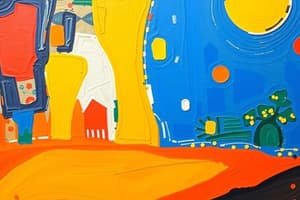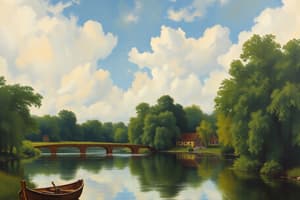Podcast
Questions and Answers
What is a metaphor?
What is a metaphor?
A figure of speech in which a comparison is drawn between two dissimilar or unlike things without the use of like or as.
In the first stanza of Byron’s poem, which literary device is used in the lines, "She walks in beauty, like the night / Of cloudless climes and starry skies;"?
In the first stanza of Byron’s poem, which literary device is used in the lines, "She walks in beauty, like the night / Of cloudless climes and starry skies;"?
- Onomatopoeia
- Personification
- Metaphor
- Simile (correct)
Explain the metaphor, "Nameless Grace" in the line, "Had half impaired the nameless grace"
Explain the metaphor, "Nameless Grace" in the line, "Had half impaired the nameless grace"
It symbolizes the woman's perfect, indescribable beauty, implying a sense of harmonious balance in both her physical appearance and inner character.
Explain the metaphor, "raven tress"
Explain the metaphor, "raven tress"
Explain the metaphor, "Where thoughts serenely sweet express"
Explain the metaphor, "Where thoughts serenely sweet express"
Explain the personification used in the lines "The smiles that win, the tints that glow, / But tell of days in goodness spent"
Explain the personification used in the lines "The smiles that win, the tints that glow, / But tell of days in goodness spent"
Explain the synecdoche used in the lines, "A heart whose love is innocent!"
Explain the synecdoche used in the lines, "A heart whose love is innocent!"
What is the difference between literal language and figurative language?
What is the difference between literal language and figurative language?
What is a simile?
What is a simile?
What is personification?
What is personification?
What is hyperbole?
What is hyperbole?
What is an oxymoron?
What is an oxymoron?
What is onomatopoeia?
What is onomatopoeia?
What is diction?
What is diction?
What is imagery?
What is imagery?
What is a paradox?
What is a paradox?
What is the key difference between a sonnet and an epic?
What is the key difference between a sonnet and an epic?
What are the key elements of a play?
What are the key elements of a play?
What is a monologue?
What is a monologue?
What is a playwright?
What is a playwright?
What are the key distinctions between a novel and a drama?
What are the key distinctions between a novel and a drama?
What is a conflict?
What is a conflict?
What are accessories in a play?
What are accessories in a play?
What is the main conflict of the play 'Macbeth'?
What is the main conflict of the play 'Macbeth'?
Lady Macbeth is a complex character who shows signs of humanity, but she is ultimately driven by her ambition.
Lady Macbeth is a complex character who shows signs of humanity, but she is ultimately driven by her ambition.
Macbeth is depicted from the beginning as a villain, consumed by ambition and darkness.
Macbeth is depicted from the beginning as a villain, consumed by ambition and darkness.
The play Macbeth is considered a tragedy, as it explores themes of ambition, guilt, and the consequences of violence.
The play Macbeth is considered a tragedy, as it explores themes of ambition, guilt, and the consequences of violence.
How does Austen use the literary device of free indirect discourse in Pride and Prejudice?
How does Austen use the literary device of free indirect discourse in Pride and Prejudice?
What are the key themes explored in Pride and Prejudice?
What are the key themes explored in Pride and Prejudice?
How does Austen use satire to critique social conventions and societal expectations in Pride and Prejudice?
How does Austen use satire to critique social conventions and societal expectations in Pride and Prejudice?
How does the character Elizabeth Bennet embody both pride and prejudice?
How does the character Elizabeth Bennet embody both pride and prejudice?
How does the concept of 'pride' evolve and transform for the character of Mr. Darcy?
How does the concept of 'pride' evolve and transform for the character of Mr. Darcy?
Social class plays a significant role in the societal dynamics and relationships depicted in Pride and Prejudice.
Social class plays a significant role in the societal dynamics and relationships depicted in Pride and Prejudice.
The pursuit of marriage is primarily driven by love and personal connection in Pride and Prejudice?
The pursuit of marriage is primarily driven by love and personal connection in Pride and Prejudice?
How does the novel Pride and Prejudice offer a critique of societal expectations regarding marriage?
How does the novel Pride and Prejudice offer a critique of societal expectations regarding marriage?
What are the four main narrative voices?
What are the four main narrative voices?
First-person narrative is the most common narrative voice in modern fiction.
First-person narrative is the most common narrative voice in modern fiction.
Jane Austen uses third-person omniscient narrative in Pride and Prejudice, giving the reader a sweeping and comprehensive view of the characters and events.
Jane Austen uses third-person omniscient narrative in Pride and Prejudice, giving the reader a sweeping and comprehensive view of the characters and events.
Flashcards
Lord Byron
Lord Byron
A prominent English poet known for romanticism and nature poetry.
Nature as refuge
Nature as refuge
Byron viewed nature as a shelter from societal worries.
Romanticism
Romanticism
A literary movement emphasizing emotion and nature over reason.
Simile
Simile
Signup and view all the flashcards
Metaphor
Metaphor
Signup and view all the flashcards
Personification
Personification
Signup and view all the flashcards
Alliteration
Alliteration
Signup and view all the flashcards
Synecdoche
Synecdoche
Signup and view all the flashcards
Shakespearean Sonnet
Shakespearean Sonnet
Signup and view all the flashcards
Imagery
Imagery
Signup and view all the flashcards
Conflict
Conflict
Signup and view all the flashcards
Theme
Theme
Signup and view all the flashcards
Diction
Diction
Signup and view all the flashcards
Oxymoron
Oxymoron
Signup and view all the flashcards
Paradox
Paradox
Signup and view all the flashcards
Onomatopoeia
Onomatopoeia
Signup and view all the flashcards
Figurative Language
Figurative Language
Signup and view all the flashcards
Protagonist
Protagonist
Signup and view all the flashcards
Antagonist
Antagonist
Signup and view all the flashcards
Narrative Point of View
Narrative Point of View
Signup and view all the flashcards
Eternal Beauty
Eternal Beauty
Signup and view all the flashcards
Social Class in Literature
Social Class in Literature
Signup and view all the flashcards
Literary Devices
Literary Devices
Signup and view all the flashcards
Theater Elements
Theater Elements
Signup and view all the flashcards
Exposition
Exposition
Signup and view all the flashcards
Climax
Climax
Signup and view all the flashcards
Denouement
Denouement
Signup and view all the flashcards
Comedy
Comedy
Signup and view all the flashcards
Tragedy
Tragedy
Signup and view all the flashcards
Study Notes
Literary Devices and Figures of Speech
- Literary devices are techniques used to create specific effects in writing.
- Figures of speech are expressions that have a meaning beyond the literal meaning of their words.
Simile
- A comparison between two unlike things, using "like" or "as".
- Example: "Life is like a box of chocolates."
- This shows a relationship between unlike things, in this case describing life using a simple box of chocolates.
Metaphor
- A comparison between two unlike things, but without the use of "like" or "as".
- Example: "You are my sunshine."
- Here the comparison is stated without the use of "like" or "as", saying directly that the individual is the sunshine.
Personification
- Giving human qualities to animals, objects, or ideas.
- Example: "The trees danced in the wind."
- Here the verb "danced" is given to the trees, something that only humans can do, to show the motion of the wind through the trees.
Hyperbole
- An exaggeration or overstatement to emphasize a point.
- Example: "I'm so hungry I could eat a horse!"
- The exaggeration of the hunger level is part of the figure of speech, a way of strengthening emphasis on the level of hunger.
Metonymy
- Using one thing to represent another related thing.
- Example: "The suits were at a meeting."
- Here "suits" refers to business people, using different items to show who is at the meeting.
Synecdoche
- Using a part to represent the whole, or vice versa.
- Example: "There are ten mouths to feed."
- Here the mouth is a part of a person which in this case represents the entire person needed to be fed.
Symbol
- A symbol is something that stands for or represents something else, often with a deeper and more meaningful meaning.
- Example: Trees often symbolize growth and nature.
Irony
- Irony is a literary device where something is said or done that is the opposite of what is meant.
- Types of irony include:
- Verbal irony: Saying one thing but meaning another.
- Dramatic irony: When the audience knows something the characters don't.
- Situational irony: When the outcome of a situation is unexpected or opposite of what is expected.
Imagery
- Imagery uses descriptive language to create vivid pictures or sensory experiences in the minds of readers with descriptive language.
- Types of imagery include:
- Visual imagery
- Auditory imagery
- Kinesthetic imagery
- Olfactory imagery
- Gustatory imagery
Oxymoron
- A figure of speech where opposing ideas are joined together to create a striking effect (like a contradiction).
- Example: "Living death".
Paradox
- A statement that seems to contradict itself but may still have some truth to it.
- Example: "I am nobody."
Onomatopoeia
- Words that imitate or mimic sounds.
- Example: "Buzz," "Hiss."
Diction
- Diction refers to word choices in writing or speech.
- Example: "I am delighted!" versus "Sure, why not?"
- The use of these phrases shows different levels of formality, and emotional/emotional tone, and attitude; which can be achieved through different choices of words.
Introduction to Literature
- Literature can be defined as any written work with artistic merit.
- Literature serves many purposes including expanding horizons; building critical thinking skills; a leap into the past; and appreciating other cultures and learning about beliefs which are different from one's own.
The Epic
- Homer was considered to be the first writer of Epics.
- The Epic poems should not contain drama and lyrics.
- The Epic style should be high and lofty in nature.
- Examples of Epic poems include the Odyssey, and the Iliad.
Poetry
- Poetry is a literary art form that uses aesthetic and rhythmic qualities of language—such as figures of speech, imagery, and sound devices—to evoke meanings in addition to the literal meanings of words.
- Elements of poetry include lines, stanzas, rhyme scheme, etc.
- Examples include the sonnet, ballad, and free verse.
Analysis of Poetry
- The analysis of poetry involves several stages to dissect the work, including paraphrasing and identifying the main theme, as well as analyzing the content, the form, and evaluating its effectiveness.
Drama
- Drama is a story meant for performance by actors.
- Elements include: characters, dialogue, theme, setting, plot, and conflict.
- Types of drama include tragedy, comedy, and tragicomedy.
- Examples include Shakespeare's Macbeth, and Euripides' Medea.
Fiction (Prose)
- Fiction is a literary work intended to portray imaginary events or characters, such as novels, short stories, and novellas.
- Prose is a type of writing that follows normal grammatical structure, such as in novels, short stories, or novellas.
- Elements of prose include theme, plot, character, setting, and viewpoint.
Studying That Suits You
Use AI to generate personalized quizzes and flashcards to suit your learning preferences.




